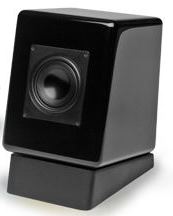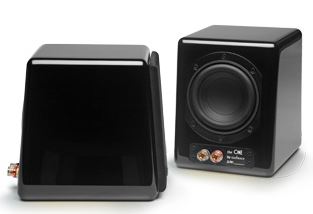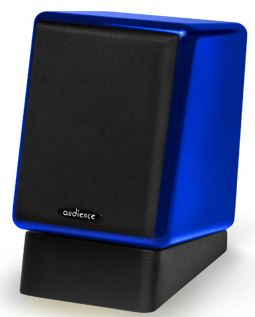It seems that lately I listen to more music more often at my desk than in my dedicated listening room. This allows me to multi-task: attend to email and other business duties, talk with customers and friends, and listen to music, all at the same time. Of course, this is not quality time with music because the volume is necessarily set to a low level since my customers seem to object to my repeated requests to “speak louder”. Even so, the volume often increases between phone calls. This gradual change in work habits has led to an increasing interest in better sound from my desktop audio system.

For many years, my office system included a mini-size Radio Shack Realistic 15 Watt receiver and a pair of B&W Solid 2-way speakers. The speakers flank a 24” computer monitor at the corners of my 4 foot wide Virco 8700 computer desk, a design once called a “machine table”. Recently, the Realistic receiver was replaced by a palm-sized Dayton Audio DTA-100a Class T integrated amplifier. Although it is rated at 50 Watts per channel, it does not seem over 3 times more powerful than the Realistic receiver. However, the sound quality of the newer amplifier is quite a bit better than the 10+ year old Realistic. David Solomon at Peachtree kindly offered to send a decco65 integrated amplifier to help with this review, but it never arrived.
Replacing music from the receiver’s AM/FM tuner section is the bewildering variety of music available on the Internet. The audio quality of these “stations” varies greatly. While many offer a great selection of music, I usually listen to my local stations for their local news and weather features. The audio signal is taken from the standard green ‘audio out’ jack on the computer motherboard via Mogami RCA interconnects. For this review, both Mogami and the new Audience Ohno speaker cables were employed in both this desktop system and in the listening room.
That system includes a Basis 2500 Signature turntable with Vector 4 and MØRCH DP-8 tonearms, Miyajima Kansui and Benz LP-S moving coil cartridges, Whest PS.30RDT Special Edition and Sutherland 20/20 phono preamplifiers, Bob’s Devices CineMag 1131 “Blue” step-up transformer, Mark Levinson 326S preamplifier with phono, Prism Orpheus Digital Interface with custom Windows 7 computer/music server, YG Acoustics Kipod II Signature Main Modules speakers, Magnepan 1.7 speakers, Dali Mentor 5 speakers (from the home theater system), and two Gallo TR-3 subwoofers. Power amplifiers are the “10 LP” Spread Spectrum Technologies Ampzilla 2000 2nd Edition. Interconnects and speaker cables are mostly Mogami. The Firewire cable joining the music server and Prism Orpheus is Audioquest Carbon. All front end components receive their AC power from a PS Audio AV-5000 power conditioner which is connected to the wall power with a Shunyata Anaconda CX power cord. A PS Audio Quintet, connected to the utility grid with another slithering Anaconda CX, is normally used for the power amplifiers. A variety of power cords are used elsewhere in the system, including Jerry’s DIY power cords which can be found on the music computer, Prism Orpheus, and Levinson preamp. The entire system is turned on and off from the Levinson’s remote control.
Size matters. Loudspeakers always need to be matched to the room in which they are used. It is easy to overpower a room with too-large speakers, and when it comes to desktop audio, speakers need to fit both physically and cosmetically. For most desktops, this means that a 2-way speaker with a maximum 5” woofer would probably be the limit of what will fit easily. But smaller is certainly better for this application. The Audience The ONE speaker is perfect for desktop use due to its miniscule size of 5.5 inches wide and 7 inches both deep and tall. They list for $995 per pair.
You have probably heard of single driver speakers. They use only one driver to reproduce the entire frequency range without a separate woofer, midrange and tweeter. They especially and importantly and significantly do not need or use a crossover. This is noteworthy because there are no good crossovers, only ones that are less bad. Most use inductors, which are long coils of wire (how much did you pay for your speaker cables?), and capacitors and resistors. Good sounding capacitors can be very expensive. Sonically, these parts harm the signal and create phase problems, very often in the midrange where the most important musical elements live and breathe. They waste power which reduces the dynamic performance. But crossovers are required to combine separate woofers, midranges and tweeters in a complete speaker. Eliminating the crossover is a major benefit of single driver speakers that is easy to hear.

The difficulty in making a speaker driver that can go from bass to treble successfully is that the concept defies physics. Bass wavelengths are big and require moving lots of air. Treble frequencies are very small and require very fast movement of the dome or cone. So a bass driver is typically large and a tweeter is much smaller. The 3 inch Audience A3S driver has a “massively oversized” magnet and a titanium alloy cone that weighs only 2.5 grams which is why it can reproduce much of the audio frequency range.
The first thing you will notice is the outstanding clarity from the midrange through the nicely extended treble. However, this is not simply a trick that our ears often play when we hear something new. This impression of clarity, octave-to-octave consistency and harmonic coherence, and freedom from distortion is apparent on every listen, from day 1 to day 101 and beyond.
The ONE projects a large size sound field that is more common with large 2-ways or smaller modern domestic 3-way floorstanding towers. There is a very nice perception of depth, although not quite as filled in at the rear corners as the much more expensive Kipods. The ONEs offer an excellent center image with a natural size of the performer, not an artificial pinpoint source of sound. There is a continuous left to right sound stage with no bunching towards the center. The stage occasionally extends outside and wider than the locations of the speakers themselves, which speaks of excellent manufacturing quality control and unit-to-unit consistency.
Placement is very important for correct frequency balance. Too far into the room and away from the rear wall and the upper bass and lower midrange become weak. On 24” stands – 36” would be better – 6” closer to the rear wall brought up the lower mids nicely. Too close to the rear wall, however, throws the soundstage forward. These speakers have outstanding projection of the sound field and are easily capable of completely disappearing as the source of sound.
Regarding stands, it is definitely worth your time to experiment with toe in and “toe up” by using the Audience tabletop stands atop the floor stands. The Audience tabletop stands are a $75 option. I preferred using the Audience stands in the regular listening room. Desktop use is fine without since the rear-firing bass passive radiator seems more effective when the rear of the speakers are parallel and close to the rear wall. The clarity in the upper midrange through the treble increases when the magnetically-attached grills are removed. The speakers have very good dispersion that makes precise toe-in largely unnecessary. This is important for desktop use because we usually have limited placement options. The soundstage can be adjusted somewhat by adjusting the toe-in angle. There is only so much air that these diminutive drivers can move, and as with most small speakers, bass augmentation will probably be welcome is most installations. Bass performance is affected to a large degree by the speakers’ distance from the rear wall due to the small rear-mounted passive radiator.
From the owner’s manual:
“ONE caveat we must offer is that because the ONE is so uncolored and distortion-free that the tendency of the listener is to turn it up. In small spaces this should not be a problem. However, in larger rooms, one could easily over-drive the speaker and cause damage. In such a situation we recommend pairing the ONEs with a quality subwoofer, preferably one that allows you to limit the low frequencies delivered to the ONE, a very desirable thing if one is trying to fill a rather large room with sound. There are a number of excellent subwoofers on the market. If you would like a recommendation, please feel free to call us. If using the ONEs in any room without a subwoofer, you can tune the apparent bass output by moving the ONEs 6” to 24” from the wall behind the speakers.”
It is usually the big dynamic peaks that could overdrive any speaker. You will get Frank Sinatra to play louder than you will the Black Eyed Peas. The speakers are comfortable at 90 dB at 1 meter, which worked out to about 80 dB at the sweet spot in my listening room. This loudness level is sufficient to make conversation a bit challenging. The little Dayton Class T amplifier’s 50 Watts seems barely adequate for loud desktop listening, or it could be the amplifier itself as it was apparent that some distortion was present at high volume settings. This was not observed when the speakers were played quite loudly with the 300 Watt Ampzilla 2000 2nd Edition amplifiers. For a smaller listening room, about 20 to 100 Watts of good clean amplifier power would be fine.
Every speaker has some character of its own. This is sometimes due to its interaction with the listening room. Speaker character usually falls into two categories: the “more or less” character, where there is more or less bass, more or less midrange, more or less depth, etc. The other character is “good or not”, where the bass is good or not, the vocals are good or not, etc. “More or less” is a quantity measure, and “good or not” is a quality measure. Whether or not you have a long term relationship with The ONEs will not depend on its “good or not” grade: they are very good. This just happens to make the “more or less” character much less important.

The Audience Ohno speaker cables, $249 for a 5 foot pair, are a good match. The Ohno cables were developed especially for the ONEs. They are OFCC (oxygen free continuous cast) copper. Their notable clarity in the upper treble along with an organized and focused soundstage makes them good partners for The ONEs.
The cabinets are very nicely made. Their seamless appearance and high gloss, furniture grade finish, which is available in several colors, will be welcome in any setting. They have the look and feel of a high quality product, solid but not overly heavy at 4 pounds each. There must be some clever design secrets inside to enable this remarkable sound quality from so small a speaker.
The ONE’s delightful consistency of tone is fully developed after about 100-150 hours of break in. They offer excellent resolution and treble performance. These aren’t ribbon or electrostatic tweeters with laser-like resolution, but can easily compete with almost any cone or dome tweeter on the market. Cymbals and bells ring truthfully with a natural shimmering fade.
These tiny speakers sound LARGE. As you can easily see, The ONEs are small speakers and although they sound much larger than their palm size footprint would suggest, ultimate loudness and bass extension seem to be the only limits. If you like to “crank the tunes” in other than a small room you might consider one of Audience’s larger models. For desktop use, placed close to the rear wall and preferably with a subwoofer, The ONEs offer outstanding naturalness and freedom from distortions of all types.
Audience’s The ONEs are a huge musical success. Their truly wonderful consistency of tone and coherence are very enjoyable and satisfying. This quality or character transcends price as many, or possibly most, very high end speakers fail to some degree in this absolutely critical area. At only $995 per pair, The ONEs are a terrific bargain. Their natural character makes them a pleasure to listen to for hours at a time. The ONEs are easily the best sounding speakers I have heard at or near their asking price. They leave many much more expensive speakers in the dust.
Overall Rating: 9.5 LPs
Link to manufacturer: Audience
